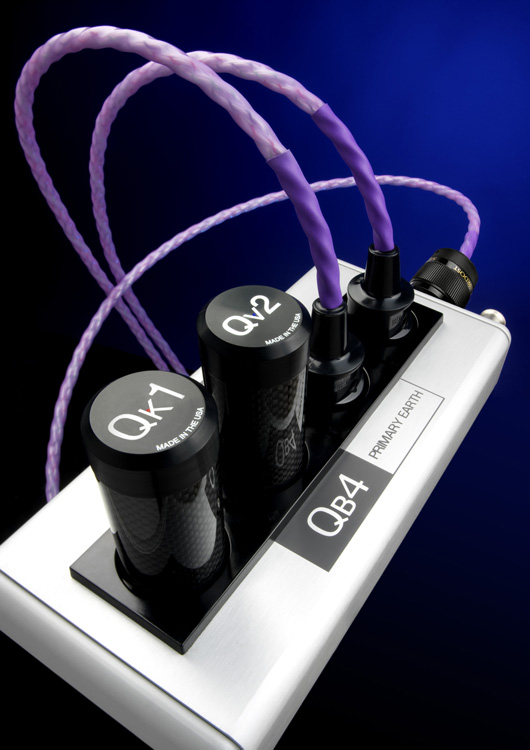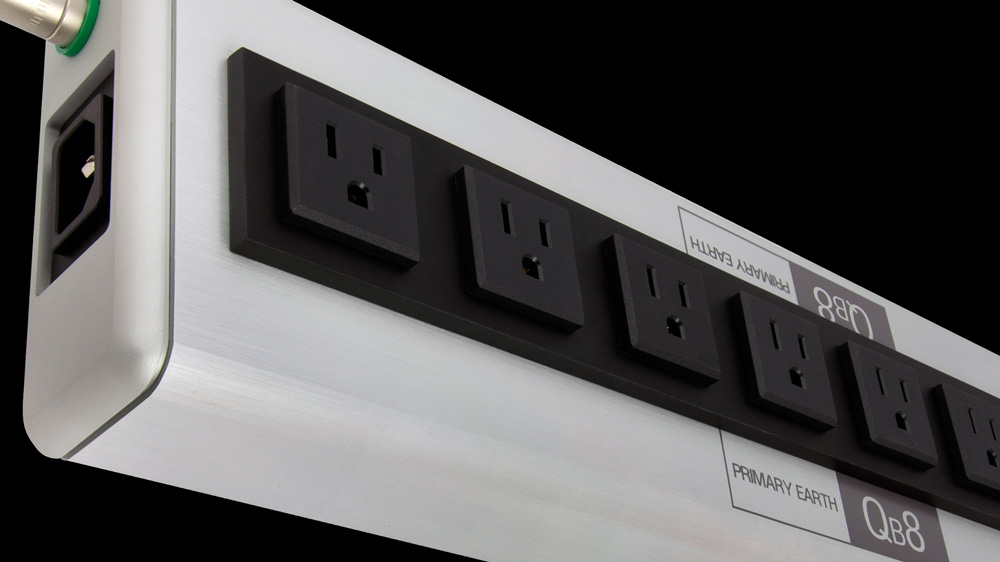Introduction
Reviews sometimes assume a life of their own. This review or at least the idea for this review began when a friend (Sherri) brought a number of Nordost QKOIL models (QV2/QK1) to my home one afternoon so that I could hear them in my system. I had previously visited her home for a demonstration of the QK1 and QV2 and really liked what they did in her system, but was not sure how they might affect my own system. The effects of each were easily discernible and, to my ear, positive; however, a formal review requires living with a piece of equipment over an extended period and, most importantly, listening to the original configuration of the system after the changes have been removed. Keeping this in mind, I approached Nordost to request pairs of the QK1 and QV2 for audition. They asked about my system, its configuration and the areas which might be improved. Then, they sent what they thought was necessary to address my needs which included sufficient power cords and other AC products to do my entire system (six boxes worth). As it turned out, this was the right approach and as they said, as good as the QK1 and QV2 may be they are really the icing on the cake, to be used after insertion of the QBASE and the QX2/4.
The problem
We live in a world where radiated pollution, instability and interference undermine AC line quality, seriously affecting the performance of electronic systems. When we listen to music through a hi-fi system or watch a movie on a home theater, what we are actually hearing and seeing is the power supplies that drive that system, and on a more fundamental level, the power that is fed to those systems from the power grid. The quality of the electricity reaching our system is critical to its performance. EMF and RFI noise and waveform distortion all undermine the performance of our components. While conventional filters can limit the destructive impact of these problems, in many instances they impose their own associated performance issues, often raising source impedance and reducing peak current capabilities of the AC line. These limitations cause their own readily audible or visible side effects, often limiting musical dynamics and robbing images of depth and color. The remainder of this article attempts to suggest a strategy for improving your AC power.
The first challenge is to make the most of the AC supply we already have. That means connecting our AC line to the system as directly as possible, without interfering with its source impedance or peak current capability. It also means optimizing the distribution topology and grounding.
If you own your own home, the place to start is at the breaker box. Simply having an electrician check the connections inside the box, cleaning the contacts, tightening the mechanical connections, and checking the system ground will almost always result in an audible lowering of the noise floor and a concomitant increase in dynamics. The next logical step is to have the electrician install one or more dedicated lines from the box to the system’s AC outlets. This will help isolate the electronics from the noise generated by household appliances such as refrigerator, florescent lighting and switch mode power supplies (such as in the computer). The last step in this initial phase is to replace your builder grade AC outlets with something better.
I have another friend (Frank) who has been using the ATL-2000 copper outlets but recently did comparisons of the Oyaide R1 and R0, the ATL-2000 copper and gold, and the Furutech GTX-D. He consistently found the gold plated outlets too laid back and rolled off at the top. Of the group mentioned, he found the Oyaide R0 to be the most neutral with a natural tonal balance, lots of detail and exceptional sound staging. The R1 was not quite as smooth, more forward and a bit tipped up. The ATL2000 copper sounded similar to the R0 but was not quite as smooth and somewhat lacking in bass power and solidity. The Furutech GTX-D rhodium was also well balanced, second only to the Oyaide R0. Depending on your system and your tastes, your preference might vary; however, the point is that outlets can make a rather audible difference in the sound and any of the outlets mentioned will be a significant upgrade from what is now in your wall.
At this point, you are ready for the next step which is where the Nordost power products enter the picture. The Nordost AC treatment products are not a one-box solution. Rather, Nordost takes a sequential approach to addressing AC problems. This has the very real advantage of allowing an audiophile to add products one at a time as earlier purchases never become obsolete.
The next step
The heart of any high quality AC supply is grounding. Nordost employs what they refer to as “star earth grounding” in their QBASE AC power distribution boxes. Creating a tiny lift in the earth impedance of all but one of the outlets allows the signal to connect directly to a clear ground terminal, providing the lowest possible AC supply impedance without any line filtering or other active circuitry. All Nordost chassis are mechanically tuned, designed and tooled to specific dimensions with the end caps machined from high quality aluminum billet. The tuning and sheer weight ensure rigidity and freedom from mechanical resonances. Unfortunately, the small rubber feet with which the QB8 was provided detracted from its performance. For best results, any of the QBASES should be placed on a stable, solid surface such as a shelf of your equipment stand with isolation/coupling feet, such as the Nordost Sort Kones underneath the QBASE.
As you might expect, the Nordost Sort Kones work extremely well in this application. They are available in three models. All use ceramic bearings in combination with a metal structure to drain energy away from the component. Each uses a different metal (aluminum, bronze or titanium) as a path for energy. All increase detail, lower noise, improve leading edge definition and tighten bass; however, each sounds somewhat different and each is more or less successful in lowering noise, increasing resolution and improving focus and dimensionality. Each will clearly and rather dramatically improve the performance of the QBASE. My personal preference is the titanium (TC), but some will prefer the warmer sound of the bronze (BC). Visco-elastic materials seem in this application to soften leading edge and dull the top end response.
The QBASE is available in two versions, one with four outlets and the other with eight. Other than the number of outlets and the size of the box in which the outlets are mounted, the two are the same. The availability of four and eight outlet versions allows you to tailor your choice based on your system needs and the location of your equipment.
The quality of the power cord from the wall to the QBASE will also have an audible effect on the sound. Not surprisingly, it works exceptionally well with Nordost’s own power cords, particularly the Norse series. Your line stage or integrated amp should be connected to the Primary Earth Socket which is located at the center of the QBASE. The QBASE has a WBT binding post, which should be connected to an independent, clean ground.
Nordost is quite emphatic in recommending that the first product which a potential customer purchase be the QBASE as they feel that it is the foundation on which their clean power approach is based. If anything, I would be even more emphatic in my recommendation. The QBASE surpasses most of the power distribution devices on the market, regardless of price.
- (Page 1 of 2)
- Next page →



Hi,
An excellent commentary on the various components. However don’t be too hard on the rubber feet. I have just upgraded the QB4 & 6 to Mk2 status & the improvement is one of the most remarkable improvements in musical articulation & engagement i’ve heard in years. I also use QX 2’s & 4’s, etc not to mention a complete Valhalla 1 loom. I have Sort tc’s under my source components but can’t afford them under another 6 boxes. Nordost would probably suggest i’m wasting my time by not moving the 3 sets I have to the first QX 4 & QB’s. Hey you know perhaps I should try it.
Keep up the great work.
What is the internal wiring of the QX4 ?
I was completely stunned when I put a QB4, Qx4 and pairs of Qv2/Qk1s in my source rack a year ago with Heimdall 2 power cords on the input to the the QB4 and Qx4. My Nordost dealer recommended I start with power cords and based on the performance of the Blue Heaven loom with which I began, I too the plunge. I have never regretted spending the money and recommend the Nordost QRT solution myself.
Based on your experience with improved decay, I suspect the power conditioning of the Nordost QRT components are enabling my Lyra Dorian to deliver a warmer mid-range with the note decay most reviewers say is missing from this generation of Lyra cartridges. In fact, I had a spooky moment the other day with my eyes closed when Nora Jones took a breath right next to me on the Painter Song from the latest Analog Production pressing of her “Come Away with Me” album. The contribution the Nordost QRT system makes to delivering this performance is greater than I ever imagined until I tried it.
I used two Qv2 as a standalone in my system plugging them into wall outlets that had a power conditioner and the other my amp. The affect was immediate and outstanding. I agree with the reviewer and how the mids seem more pronounce and the bass seemed warm and sustained. I look forward to adding the Qbase and getting rid of my Monster MKII 3600 hts. I believe at this price point, nothing comes close to how much this improves the sound quality of your favourite songs.
To achieve the lowest noise level of the QBase4/8, they must be connected to a secondary ground…which is logical if it can be done.
However, if one lives in an apartment, as I do, it will be either impossible or dfficult: the only solution I might have, is to connect the QBase4 to an unused radiator terminal up from the floor as the radiater to which was attached, has been disconnected.
Does anyone know if this will work, and how to do it? I am at a loss and buying a QBase4, without maximising it full potential, is wasteful and illogical.
I wonder if Nordost has any white papers that proves that this unit improves on Sonics. If you really want to improve things just buy better speakers. LOL What is the internal wiring, what engineering is behind this thing, and why specifically does this help? I mean if you live in downtown New York where you power grid is full of unwanted noise then maybe I could hear some improvements. If you in a newer home that is wired correctly and or have a dedicated circuit for your HT or Audio Gear than this is extreme overkill.